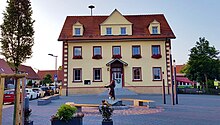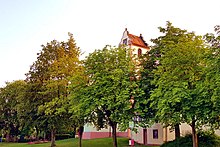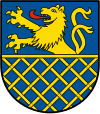Hochemmingen
|
Hochemmingen
City of Bad Dürrheim
|
|
|---|---|
| Coordinates: 48 ° 1 ′ 46 ″ N , 8 ° 34 ′ 3 ″ E | |
| Height : | 776 m above sea level NN |
| Area : | 9.81 km² |
| Residents : | 1419 (June 30, 2014) |
| Population density : | 145 inhabitants / km² |
| Incorporation : | January 1, 1972 |
| Postal code : | 78073 |
| Area code : | 07726 |
Hochemmingen is the largest district of Bad Dürrheim in the Schwarzwald-Baar district in Baden-Württemberg ( Germany ).
location
Hochemmingen is exposed on a truncated, fertile mountain at the eastern end of the Baar , which offers an impressive view. The village, an Alemannic cluster village , is centrally located in the 981 hectare area and extends mainly from north to south.
The soils of Hochemmingen are fertile. Because of the clay-rich, cold soil, however, they are difficult to work. In depressions, the soils also tend to become swamped. However, the former fens have been almost completely drained.
Geologically speaking, Hochemmingen is on the saddle of the second transition stage to the Jura . The district reaches its highest point in a hill to the northwest, the "Eckbühl", at 799.2 m above sea level. d. M.
The location of Hochemmingen on the eastern edge of the Baarhochmulde means that extremely low temperatures are reached at its lowest and therefore coldest point (down to −33.6 degrees).
Place name
The name Emmingen is said to be derived from the Alemannic personal name Emo . The place name was first mentioned as Omingin 1120 in a document by Pope Calixt II for the monastery of St. Blasien. In 1256 the spelling was Emmingen, 1409 Emmingen vor dem Walde and 1579 Hochemmingen in the Höwen lordship.
history
Hallstatt period

The Celtic section castle on the nearby Türnleberg (790 m) between Schwenningen am Neckar and Hochemmingen goes back to the Hallstatt period (800–450 BC) . The complex was probably built as a refuge by a tribal prince. The section castle rises about 25 m above the immediate vicinity and was secured all around by moats. There are several Hallstatt-era barrows at the foot of the mountain. A lord of the Celtic section castle is buried in the largest burial mound south of the Türnleber Ridge.
middle Ages
In 1113 the Fronhof von Hochemmingen was donated by the Baron von Hochemmingen to the monastery of St. Blasien (Hochemmingen was first mentioned in a document). This Fronhof came to the Sankt Georgen monastery in the Black Forest in 1739 and was divided into two courtyards in 1786. Since the former tithe barn burned down completely in 1669, the sandstone above the entrance with the coat of arms of Kaspar I from 1549 (left side with the Bläsischer coat of arms with the jumping stag opposite) was probably inserted into the new building when the tithe barn was rebuilt.
A second Fronhof belonged to the Amtenhausen Monastery , the oldest women's monastery founded by St. Georgen. This farm is listed first in all land records from 1312 to 1508 and has always been cultivated. In 1312 fields and interest goods were listed as Fronhof, in 1329 these were no longer mentioned and were evidently distributed among the peasant fiefs. This was probably the Vogtslehen of Count Wolfgang zu Fürstenberg , of which it says in a document of April 24, 1497: "Heinrich von Buoch received the following items from Count Wolfgang zu Fürstenberg for himself and his brother as a right man's fief: the Vogtei zu Hochemmingen . "
From the 11th century onwards, the barons of Wartenberg (formerly known as the knights and nobles of Geisingen ) ruled Hochemmingen and other places in the Baar . In 1281 the male line of these barons died out, but Anna, the daughter of the last baron von Wartenberg, married Heinrich I, Count in Freiburg im Breisgau and Badenweiler . Her daughter, Verena, was married to Heinrich II von Fürstenberg-Baar in 1307, so that Hochemmingen was inherited by the Counts of Fürstenberg in 1321. There was also a Dienstmann family "von Emmingen" from the waiting mountain-Fürstenberg family, but they gave up their ownership of Hochemmingen early on and died out in the 15th century.
In the Middle Ages there was a castle stable on a plateau near the Hallstatt period castle on the Türnleberg . This castle stable was mentioned several times in documents. First in 1349, then in 1570 and finally in 1703 as "Burg Falkenstein". In the Middle Ages, this castle stable secured a trade route coming from Villingen and leading to the Danube via Hochemmingen.
Modern times
At the beginning of the Peasants' War in 1524, the Hochemminger refused allegiance to the peasant leader Hans Müller von Bulgenbach. They justified their absence from the peasant uprisings by saying that they wanted to stay with the Lords of Fürstenberg, because they meant well with the poor people.
As early as 1632, the church was partially destroyed during the occupation by the Swedes and its bells were robbed. The general field master in the Swedish service Georg Friedrich vom Holtz zu Niederholz planned the water siege of the city of Villingen from here.
As a result of the Napoleonic wars and the mediatization in the Reichsdeputationshauptschluss , the princely-Fürstenbergische Hochemmingen briefly became part of Württemberg in 1805 , then later part of Baden .
In 1697 the first communication about teachers and schools can be found in a church fund invoice about an issue to the “schoolmaster for hard work in church singing”. After the land register of 1788, the "normal school" was introduced and in 1858 the former schoolhouse with town hall and teacher's apartment was built.
Fire accidents
Hochemmingen was hit twice by severe fires. In the great fire accident of 1602 the whole village burned down. A "Jauner" (thief), from whom the Hochemminger had refused the night hostel, set the whole village on fire. Only the church was spared. In the second conflagration in 1669, numerous buildings such as the Zehntscheuer were destroyed. The church was also affected in this second fire. Only the image of St. Trinity was spared.
In 1790 Hochemmingen had 270 inhabitants.
Baden time
In 1814 Hochemmingen had 62 houses and 385 inhabitants. For 1814 there is also evidence of a Baden grand-ducal military duty in Hochemmingen.
In March 1838, smallpox broke out in Hochemmingen . About every tenth inhabitant of Hochemmingen, which at that time had around 400 inhabitants, contracted smallpox. From Hochemmingen, the disease spread to the neighboring towns of Aixheim , Weigheim and Tuningen . The smallpox epidemic ended in July 1838.
The community leaders of Hochemmingens and seven other communities met on April 13, 1848 in Sunthausen . They decided not to obey the calls of Friedrich Hecker and Gustav Struve ; the representatives from Villingen and Dürrheim were the only ones who did not sign the resolution. At the time of the 48 revolution , 458 people lived in Hochemmingen, whose composition was as follows: 83 families, 7 Protestant residents, 451 Catholic residents, 226 men, 232 women.
In 1852 Hochemmingen belonged to the Donaueschingen district and the Seekreis district .
post war period
Up until the 1970s there were 75 farms in Hochemmingen, today there are only six. The formerly independent village was incorporated into the city of Bad Dürrheim on January 1, 1972 and is now part of the Schwarzwald-Baar district. It is the most populous district of Bad Dürrheim. It has its own local administration with a local mayor and local council. The volunteer mayor is Helmut Bertsche.
coat of arms
| Blazon : “In blue divided by a gold (yellow) bar; above a growing, red-tongued golden (yellow) lion; below a golden (yellow) slanting grid. " | |
| Reasons for the coat of arms: The coat of arms was awarded in 1896. The coat of arms goes back to the private seal of a Fürstenberg Vogt from the second half of the 18th century. The coat of arms was adopted by the municipal council in 1896 at the suggestion of the curator Wagner. The meaning is unclear. |
Festivals
Patronage
The local patronage festival is celebrated annually on the Sunday after Peter and Paul (29.6.) With a procession around the Catholic church of the same name.
Carnival
The carnival in Hochemmingen has always been of great importance and can be traced back to the 18th century. The fact that the fool's guild can look back on a long tradition can be demonstrated by a “ fool's sheet” from 1897. The guild of fools was re-established in 1976 from the old guild of fools "Early on - late home", as interest in the old guild was threatening to die out. The main task of the newly created association is to maintain and continue the local carnival customs . The fool's guild is a member of the Black Forest fool's association and takes part in the fools' meeting of the association.
The main character is Eckbühlblätz. But in addition to the Hästrägers, there are also the fools' councils and board members, the Eckbühlvogt, the guard, the Guggenmusik "Blosköpf" and a theater group.
The Häs des "Eckbühlblätz" was created in its current form in 1973 and first appeared at the 1975 carnival. The Häs named his fools after the highest elevation in Hochemmingen - the Eckbühl . Two ash trees that are under conservation are enthroned on its top, visible from afar. The term "Blätz" was already used in the Alemannic language. The common people could not wear the best clothes for everyday work. So a work garment was sewn together from all the still usable pieces of fabric, the so-called “Blätzle”. The Eckbühl-Blätz, on the other hand, is not made up of nothing but remnants, but for an adult Häträger consists of about 4000 red and black Blätzle, cut out with hand scissors. The Blätzle are sewn onto the coat and trousers according to a specified pattern. The hood is also equipped with Blätzle. A red felt comb is attached to the back of the hood, symbolizing the biodiversity of the bird world. As a sign of the ash trees on the Eckbühl, the Häträger carries a turned stick in their hand. The red fox tail and the many bells sewn onto the rabbit symbolize the cunning of fools.
The origin of the Eckbühlvogt is based on the history of Hochemmingen: The Vogt of the Fronhof , who had the task of collecting the tithe, was compensated almost exclusively with grain in Hochemmingen. The Eckbühlvogt wears ears of corn on his hat as a sign of the richness of the grain harvest from the Reutfelder at Eckbühl . In the basket he was taking with him there are other goods that were earned or harvested in Hochemmingen: including bread, bacon, sausage, cider. The Eckbühlvogt has embroidered the Vogtshaus with the stepped gable on the back of his red coat and the Eckbühl with the ash trees can be seen on the front.
In 1998 the Ried- Hexen Hochemmingen were founded. Her hat consists of a purple skirt, which symbolizes the "dark forces" that the old woman has; an orange apron for the fire in which the sorceress was burned; from a green checkered blouse, which stands for the swampy and swampy habitat of women; from a black cloth on the wooden clamp, which stands for mourning. The wood schemes are handcrafted by a regional mask carver .
Attractions
The parish church of St. Peter and Paul as well as the Fron-Vogtshof of the former Amtenhausen monastery and the nearby Türnleberg, on which a Hallstatt-era fortress was located, are worth seeing. The spur facing west of the section castle was secured all around by moats, the outer embankment of which was supported by palisades. Nearby on an isolated plateau was a medieval castle stable (documented mention in 1349, 1570 and 1703 as Falkenstein Castle), which in the Middle Ages secured a trade route from Villingen to the Danube. In addition, surrounding Hallstatt find barrows ; A head of the Celtic section castle was buried in the largest burial mound south of the Türnleber Ridge ("Burgherrengrab").
The parish church of St. Peter and Paul as well as the Fron-Vogtshof of the former Amtenhausen monastery and the nearby Türnleberg, on which a Hallstatt-era fortress was located, are worth seeing. The spur facing west of the section castle was secured all around by moats, the outer embankment of which was supported by palisades. Nearby on an isolated plateau was a medieval castle stable (documented mention in 1349, 1570 and 1703 as Falkenstein Castle), which in the Middle Ages secured a trade route from Villingen to the Danube. In addition, surrounding Hallstatt find barrows ; A head of the Celtic section castle was buried in the largest burial mound south of the Türnleber Ridge ("Burgherrengrab").
Club life
Club life is lively. The oldest club in town is the Musikverein, which was founded in 1901. The club with the largest number of members is FC Hochemmingen. The fools guild was founded in 1976. The Landjugend Hochemmingen is also very active.
literature
- Paul Revellio : The district of Villingen. Karlsruhe 1951.
- Kurt Hochstuhl, Regine Schneider: Political associations in Baden 1847–1849.
- Kurt Hochstuhl: Unpublished Records. 1997.
- Martin Münzer: The history of the village of Neudingen. Neudingen 1973.
Web links
Individual evidence
- ↑ Württembergisches Urkundenbuch, Volume 1, No. 273
- ↑ Almanac 2012 extract. Retrieved August 17, 2018 .
- ↑ Almanac 2012 extract. Retrieved August 17, 2018 .
- ↑ Historical statistical-topographical lexicon of the Grand Duchy of Baden (etc.) . Maklot, 1814 ( google.de [accessed August 15, 2018]).
- ↑ Historical statistical-topographical lexicon of the Grand Duchy of Baden (etc.) . Maklot, 1814 ( google.de [accessed August 15, 2018]).
- ↑ Historical statistical-topographical lexicon of the Grand Duchy of Baden (etc.) . Maklot, 1814 ( google.de [accessed August 15, 2018]).
- ↑ Emil Osann: CW Hufeland's Journal of Practical Medicine: December . Printed and published by G. Reimer, 1838 ( google.de [accessed on August 16, 2018]).
- ↑ Almanac 2012 extract. Retrieved August 17, 2018 .
- ^ Federal Statistical Office (ed.): Historical municipality directory for the Federal Republic of Germany. Name, border and key number changes in municipalities, counties and administrative districts from May 27, 1970 to December 31, 1982 . W. Kohlhammer, Stuttgart / Mainz 1983, ISBN 3-17-003263-1 , p. 504 .
- ^ Coat of arms of Hochemmingen
- ↑ Almanac 2012 extract. Retrieved August 17, 2018 .








